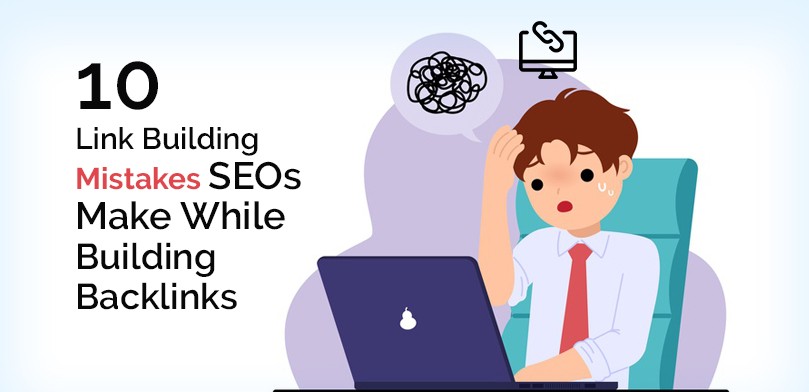Link building is one of the most vital SEO activities. It also influences your Google search rankings. Link building builds trust between the other websites, your website and even the search engine. We believe that it is still a rock-solid SEO strategy that can generate traffic and expand online presence. So, it is vital to do it right.
There are many ways to create a strong link building strategy. However, even seasoned SEO specialists commit mistakes, which can negatively impact your website, causing a loss in traffic, leading to some websites getting penalised in the most severe cases.

Mistake #1: Wandering away from the goals
There is a reason or a purpose you are doing all these marketing campaigns and link building activities.
For example, optimising your SEO is meaningless if you haven't done anything for CRO (Conversion Rate Optimisation).
There is no point sending all the traffic to your website if you haven't optimised for conversion. If those visitors don't click on your "Buy" button at some point, they're worthless.
And as part of SEO, link building exists within a context as well.
When you execute a marketing campaign, you have o clearly define the objective and goals in mind. Make it as clearly defined as you can.
Even if you do not have a definite goal in mind, you must have some thought process.
Then follow this consistently.
Now that you have a plan in place, you can develop a strategy, choose your tactics, and then start hunting those links to generate backlinks.
Mistake #2: Thinking more is better
Quality content acts as fuel for your link building engine and is a must for your success. You're your long-form content should always be quality-focused and not quantity.
You should aim to create authoritative content which is useful instead of just adding info to add length.
When creating long-form content or visualising data, pick the most interesting data.
What should you do then?
Audit your content and remove text that is
- Less relevant
- Less interesting and
- Less useful
Examine each section of your long-form content and ask yourself: "what do we lose if we remove this item?"
If removing that piece of content loses relevancy or usefulness, then you must keep it.
If it's vice versa, you are merely looking at filler content that will not impact your content and context when removed.
Mistake #3: Forgetting to break large blocks of content
Long posts or large content blocks can overwhelm readers quite easily. They may feel bored, lost and will eventually navigate away from your website.
Long guides or the solid blocks of the content does not persuade anyone to link. Similarly, the long infographics that go on and on may quickly lose the reader.
What should you do instead?
Your focus should be to make your long solid content block easy to read. You can achieve that by breaking it into smaller digestible content blocks.
- Add design elements to your page so that it doesn't look plain solid text.
- Build custom navigation.
- Support your content with videos, graphics, screenshots etc. for better understanding. And in case of infographics, you can:
- You can divide it into a few smaller designed assets and then bring them together into a story.
- Create sections for different niche audiences.
Mistake #4: Obsessing over Domain Authority
Using third-party software to identify high-quality link building opportunities is fine, but following it blindly can lead to poor SEO results and ineffective link building.
Obsessing over third-party software to find link building opportunities based on domain authority may lead to:
- Limited opportunities
- An absence of subjective evaluation.
- Creating an unbalanced link profile.
What should you do instead?
When a link building opportunity knocks the door, never let it go. Some SEO professionals have a complex mechanism to evaluate link prospects. By the time they are through with the evaluation process, they are left with very few prospect links to reach out.
You may not convert 100% of your prospects.
Many agencies are put under a lot of pressure to build only high-DA links. In a way, it makes sense because we emphasise on quality over quantity.
But one thing you must keep in mind, and that is, metrics can change with time, and it does. Today, a high DA can go down tomorrow, and an average looking website today can become a high DA website tomorrow.
A useful link is still a good opportunity. We know it when we see it, so don't ignore it.
To make your link building profile look organic, create lots of backlinks from good links.
Consider the fact that links too have a life. Some links last for long and some last for a short while. Some may get higher domain authority in future, and others may shrink.
Consider low DA links as seeds that may grow into a tree. Some newbie website may grow into huge websites, and it may get hard to get links once they are already huge.
Creating all high DA links looks in-organic.
Mistake #5. Failing to create content that's trending
We know that there is a lot of interesting content out there but fails to earn links. No matter what content you are creating, you have to have something unique and different from others.
What should you do instead?
When you create long-form content or pillar pages, identify areas that have not been covered yet. Similarly, while creating how-to guides identify areas which are essential and cover those.
If you are creating a video or visual content, add content that's new and trending. The infographics you created long-ago are good but lack current information, and you can add something new and surprising.
Mistake #6: Ignoring timing and seasonality.
You get only one chance at promotion, do not let it go in vain. If you have a great content idea but feel that that would be great for the festive season, save it. Follow your instinct on the seasonality of the content.
What should you do instead?
Listen to your gut feeling and publish your content when the timing is right because other site owners are thinking the same way and won't cover or link to your content until the right time.
Publishing the right content at the right time can be more successful. Take advantage of the seasonality as much as you can. For example:
- Sports season
- Festive season
- Weather seasons
- Industry-specific seasons
- Election seasons etc.
A seasonal touch can leverage average content to a successful run. And, good content can take you a long way.
Mistake #7: Failing to personalise your reach.
It is an old practice where you tell the site owner/content author with a comment about how good the content was and how much you enjoyed reading it. It doesn't work anymore.
Site owners and the authors are aware of these tactics and do not consider such comments as genuine.
The author can quickly identify such mass-produced and half-hearted attempts at personalizing and usually ignore or remove such comments.
What should you do instead?
Focus on making a genuine personal connection with the author/website owner. Make your outreach template personalized to the persona.
Create an outreach persona, just the way you create a buyer persona.
Think about:
- What do they like and dislike?
- What are their pain points, or what do they stress about?
- What annoys them?
- What do they find funny?
Bring all this in your template, and you might get a response from them.
Mistake #8: Following your competitor's link profile
Doing a competitor analysis is fine, but blindly following them is not. Having the exact same links may not necessarily help you outperform.
Agreed that there are some industry-specific compulsory links, but you may fail if you plan to follow their profile.
Your competitor's list of links is your prospect's link. And, you will not have 100% conversion rate. So, in the end, your links would be much lower than that of your competition.
What should you do instead?
You can do a competitor analysis to find out what seems to work in your niche. Figure out your available resources and strengths to develop a content strategy that works for you as you build your link profile.
Mistake #9: Failing to diversify your strategy
Link building is tough, and it isn't easy to figure out how to build one type of link.
If you are fortunate enough to get to a good link building strategy, it's easy for you to get back to that over and over again and again to get similar results.
But we must not forget that we are living in a world of technology. And, the web is in constant motion. What's working today may not work next year.
It would help if you keep experimenting and making your strategies better and better to stay ahead of trends and time.
And if your link profile is made of only one kind of links, you are losing out the other opportunities.
What should you do instead?
Keep evaluating your strategies to stay ahead in the game. Evaluate your:
- Strategy to outreach
- The kind of content that'll work best for you.
- How you package it.
Keep evaluating and tweaking each element in the process for better results.
Mistake #10: Giving up too early
Link building is a slow process, and you can't see results too early.
Most of link building campaigns/processes look like:
- Ideation
- Execution
- Result (failure or success)
- Repeat.
If you've worked on a link building campaign in the past, that didn't produce good results, and you are not aware of what went wrong. Then you gave up too early.
What should you do instead?
Find out why did your campaign fail or didn't get the results you expected. If you do not examine what went wrong or what didn't work, the chances are that you may commit the same mistake in your next link building campaign.
- If no one is opening your emails, try tweaking the subject line.
- If people are opening the mail but not clicking through or responding, change your selling points/offers.
- If people are opening, clicking through but not linking, then maybe, the content isn't good enough compelling as you might imagine.
Keep working on your plan and adjust your campaign and try again. Don't stop until you have a plan that's working without a glitch.

